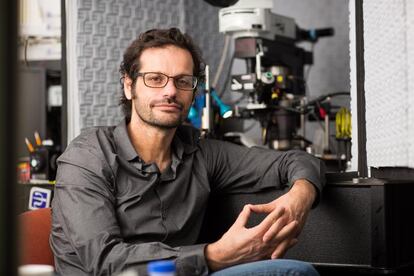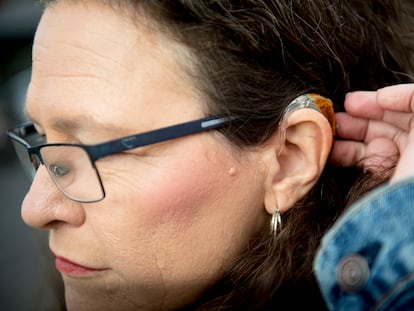Researchers discover biological mechanism behind hearing loss caused by loud noises
An experiment in mice opens the door to the creation of drugs capable of minimizing such damage, but scientists insist prevention is still key

Listening to music at full volume with headphones can affect your hearing. So can listening to loud music at a concert or in a nightclub, or performing on a stage, where the noise exceeds 100 decibels. In general, any prolonged exposure to noise that is more than 80 decibels is considered harmful to hearing. Indeed, the scientific community recommends the use of earplugs in noisy environments to prevent permanent damage. Because once cells are injured, nothing can be done to regenerate them. A group of researchers from the University of Pittsburgh, however, has discovered the biological mechanism behind hearing loss caused by loud noises — a finding that opens the door to discovering a form of prevention.
“Despite the impact that this condition has on society, today treatment strategies that protect and restore hearing are few and far between,” says Thanos Tzounopoulos, director of the Pittsburgh Hearing Research Center and author of the study, published on Monday in the journal PNAS. The experiment, carried out with mice, investigates the correlation between hearing loss and the presence of zinc — a mineral essential for proper cellular function and hearing — in the inner ear.
“It is a key element that we all need to survive. Ninety percent of zinc in the body is bound to proteins and helps them do their job. It is important for communication between different neurons and cells,” explains Tzounopoulos. “However, the remaining 10%, which is known as labile zinc, is in a free state, and plays a crucial role in cell signaling. Scientific literature tells us that when the zinc signal is deregulated or negatively affected, it can cause cell death, in addition to playing a role in the degeneration of optic nerves.”
To investigate the role of zinc signaling in response to trauma, Tzounopoulos’ team exposed unanesthetized mice to a noise of 100 decibels — equivalent, for example, to the noise of a felling machine or a nightclub — for two hours. In measurements carried out two weeks later, it was confirmed that the mice had suffered cochlear damage and that their hearing threshold had shifted. Subsequently, the researchers went on to evaluate the levels and location of zinc in the cochlea of these mice, compared to others that had been exposed to the same level of noise only one day before.
In the first group of mice, labile zinc was found mainly in the outer cells, while in the mice that had just been exposed to trauma, it was found in the inner part of the cochlea. “These results demonstrate that exposure to loud sounds causes a massive release of zinc in the intracellular space that interrupts normal communication between cells and causes deterioration,” explains Brandon Bizup, the co-author of the study, who recognizes that although the connection between the two factors is clear, they still do not know what the factors are driving this change.
After corroborating the biological mechanism behind hearing loss, the team at the University of Pittsburgh began working on a device to prevent it. Experiments showed that another group of mice — which were treated with a gel that traps the excess zinc released into the ear canal after exposure to noise — were less prone to hearing loss and were protected from the induced damage.
“The active part of the drug is a chelator, capable of extracting toxic metals from the body. We dissolved this chelator in a gel that we surgically applied to the mice directly in the ear canal,” explains Tzounopoulos. Injections were also made into the abdomen of the mice. The gel works like a sponge, trapping excess zinc and limiting trauma.

Luis Lassaletta, leader of the Otology department of the Spanish Society of Otorhinolaryngology, believes that the researchers’ conclusions on the biological mechanism behind noise-induced trauma are solid and novel. However, he points out some shortcomings of the study. “First, just as the role of zinc as a cause of hearing loss seems well demonstrated, the possibility of protecting the loss and reversing the effects is less so,” he notes. “On the other hand, there are more established mechanisms to explain noise-associated hearing loss, such as inflammation, oxidative stress and cell apoptosis.”
“This is, without a doubt, a discovery that can change the way we relate to this type of ailment,” acknowledges ENT doctor Eduardo Raboso, head of service at the La Princesa Hospital in Madrid, who did not take part in the study. “Zinc is a mineral that has a marginal but vital function in our body. And if it is handled poorly and leaves the vesicles where it should be, the damage can be permanent.” Even so, the expert is skeptical that the experiment with mice will lead to a therapeutic option for humans.
The scientists themselves are taking a cautious approach to the next phases of their research. “Before we can apply the drug to humans, we need to conduct a series of additional experiments to ensure the safety of the drug, including toxicology studies and determination of the precise dosage,” says Bizup. The scientist recalls that there is a precedent for the surgical application of zinc chelators, such as the use of steroids for sudden hearing loss. The long-term goal is to develop two types of medicines. A preventive one, in the form of a pill, that can be taken before going to a particularly noisy event, such as a concert or a soccer match. The other reactive, through surgical treatment, in case of involuntary exposure.
For this reason, researchers point out that the best cure for hearing loss remains prevention. “Awareness about the damage that noise can cause to hearing is crucial, especially in everyday events that easily exceed 100 decibels. Wearing hearing protectors is key to protecting your ears, regardless of the other measures that may come later,” says Tzounopoulos. “Hearing loss is the most common sensory disorder, affecting a significant percentage of the population, which underlines the importance of protecting our ears from harmful sound levels in everyday life.”
Sign up for our weekly newsletter to get more English-language news coverage from EL PAÍS USA Edition
Tu suscripción se está usando en otro dispositivo
¿Quieres añadir otro usuario a tu suscripción?
Si continúas leyendo en este dispositivo, no se podrá leer en el otro.
FlechaTu suscripción se está usando en otro dispositivo y solo puedes acceder a EL PAÍS desde un dispositivo a la vez.
Si quieres compartir tu cuenta, cambia tu suscripción a la modalidad Premium, así podrás añadir otro usuario. Cada uno accederá con su propia cuenta de email, lo que os permitirá personalizar vuestra experiencia en EL PAÍS.
¿Tienes una suscripción de empresa? Accede aquí para contratar más cuentas.
En el caso de no saber quién está usando tu cuenta, te recomendamos cambiar tu contraseña aquí.
Si decides continuar compartiendo tu cuenta, este mensaje se mostrará en tu dispositivo y en el de la otra persona que está usando tu cuenta de forma indefinida, afectando a tu experiencia de lectura. Puedes consultar aquí los términos y condiciones de la suscripción digital.
More information
Últimas noticias
The metaverse, four years later: Is it finished or just at a standstill?
$3,000 and a plane ticket: The United States increases incentives for migrants to self-deport before the end of the year
Charles Dubouloz, mountaineering star, retires at 36 with a farewell tour inspired by Walter Bonatti
From the White House to diplomatic gifts: Lego wins over adult fans, brick by brick
Most viewed
- The low-cost creative revolution: How technology is making art accessible to everyone
- Families demand repatriation of bodies of Colombians who died in Ukraine: ‘This war is a slaughterhouse for foreigners’
- Christian Louboutin: ‘Young people don’t want to be like their parents. And if their parents wear sneakers, they’re going to look for something else’
- All the effects of gentrification in one corner of Mexico’s Colonia Roma
- Christmas loses its festive spirit: ICE fears cast shadow over religious celebrations











































